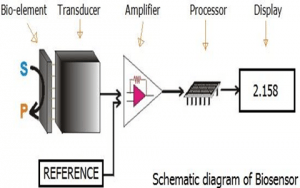 The Biosensor is an analytical device so it is used for detecting the analyte. It collects the components in biological using a detector like Physicochemical. The detecting biological elements are nothing but biometric components that communicate with the recognize as well as analyze the study & the components such as antibodies, tissue, and microorganisms, nucleic acids, etc. The biological responsive elements will generate through biological engineering. The elements of the detector transform the signals from the interface of an analyte with the biochemical elements into other signals like transducer and it can be measured more easily and qualified. The Biosensor devices are associated with the electronics and the signal processors and they are generally responsible for the display of the results and they are user-friendly. Biosensor research has a significant role in the development of modern electronics. This article discusses different types of Biosensors working and applications.
The Biosensor is an analytical device so it is used for detecting the analyte. It collects the components in biological using a detector like Physicochemical. The detecting biological elements are nothing but biometric components that communicate with the recognize as well as analyze the study & the components such as antibodies, tissue, and microorganisms, nucleic acids, etc. The biological responsive elements will generate through biological engineering. The elements of the detector transform the signals from the interface of an analyte with the biochemical elements into other signals like transducer and it can be measured more easily and qualified. The Biosensor devices are associated with the electronics and the signal processors and they are generally responsible for the display of the results and they are user-friendly. Biosensor research has a significant role in the development of modern electronics. This article discusses different types of Biosensors working and applications.
What is Biosensor?
A Biosensor is an analytical device. The sensor which integrates the biological elements with the Physiochemical transducer to produce an electronic signal is proportional to a single analyte and which is fetched into a detector.
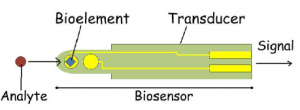
BioSensor
Working of Biosensors
The preferred biological material like enzyme is preferred for conventional methods like physical or membrane entrapment and non-covalent or covalent binding. The preferred biological material is in contact with the transducer. To produce a bound analyte through the analyte binds to the biological material which produces the electrical response to be measured. In some cases, the analyte changed to a product and have some probability to associate with the release of heat, gases like oxygen, electrons or hydrogen ions.
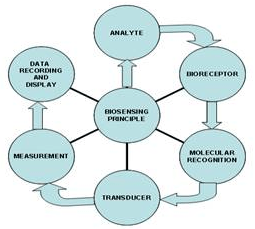
Working of Biosensors
Types of Biosensors
There are different types of Biosensors based on the sensor devices and the biological materials and some of them are discussed below.
Electrochemical Biosensor
Electrochemical Biosensor is a simple device. It measures the measurement of electronic current, ionic or by conductance changes carried by bio-electrodes.

Electrochemical Biosensor
Amperometric Biosensor
The Biosensors are based on the movement of the electron, i.e. electronic current determination as a reaction of the enzyme-catalyzed redox reaction. Generally, a normal contact voltage passes through the electrodes to analyze. In the enzymatic reaction which produces the substrate or product can transfer the electrons with the surface of electrodes to be reduced.
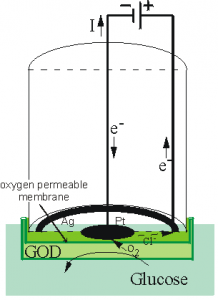
Amperometric Biosensor
As a result, an alternate current flow can be measured. The substrate concentration is directly proportional to the magnitude of the current. The reduction of oxygen is acquired through the oxygen electrodes and it is a simple way to form an Amperometric biosensor. The example is the determination of glucose by glucose.
The above description is about the first generation of Amperometric biosensor and it has a direct transfer of electrons that are released from the electrodes are having some difficulties. The second-generation Amperometric biosensors are developed in a mediator takes the electrons and transfer to the electrodes.
Blood Glucose Biosensor
Blood glucose Biosensors are used widely throughout the world for diabetic patients. It has a single-use disposable electrode with glucose oxide and derivatives of a mediator (Ferrocene) and the shape of the blood glucose Biosensor looks like a watch pen. With the help of hydrophilic mesh, electrodes are converted. Blood glucose Biosensor is a good example of an Amperometric Biosensor.

Blood Glucose Biosensor
Potentiometric Biosensor
In this type of Biosensors changes the concentration of ionic is determined by the ion-selective electrodes in this pH electrodes are used most commonly. Hence a large amount of enzymatic reactions is involved in the release of hydrogen ions. Ammonia-selective and Corbondioxide selective electrodes are some other important electrodes.
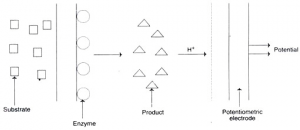
Potentiometric Biosensor
The Potentiometric electrode and the reference electrode can be measured with the help of potential difference and it is directly proportional to the substrate concentration. The Potentiometric Biosensors is the sensitivity of enzymes to ionic concentration like H+ and NH+4
The ion-selective field-effect transistors are lower-price devices. It can be used in the miniaturization of Potentiometric Biosensors. An example of the ISFET Biosensor is to monitor intra-myocardial for open-heart surgery.
Conductometric Biosensor
In the biological system, there are several reactions that change the ionic species. The electronic conductivity can be measured with the help of anionic species. The example of the conduct0metric Biosensor is the urea Biosensor which utilizing the immobilized areas. The following reactions show the urea catalyzes.
The given reaction is associated with the drastic alteration in ionic concentration and they are used for the monitoring urea concentration. In generally during dialysis and renal surgery the urea Biosensor is very useful.
Thermometric Biosensor
There are many more biological reactions are connected with the production of heat and it forms the basis of thermometric Biosensors. The diagram shows the representation of a thermal Biosensor. The diagram consists of a heat-insulated box fixed with heat exchange.
Optical Biosensors
The optical Biosensor is a device, it utilizes the principle of optical measurements like fluorescence, absorbance and etc. They used in fiber optics and Optoelectronic transducers. The optical Biosensors are safe for non-electrical remote sensing of materials. In the transducer elements, primarily optical Biosensors involves in the enzymes and antibodies. Usually, the Biosensors is not required any reference sensors and the comparative signals are generated by using the sampling sensor. The important Biosensors is described briefly.
Fiber Optic Lactate Biosensor
The working of the fiber optic lactate Biosensor is based on the measurement of change in oxygen concentration, molecular by identifying the effects of oxygen in the fluorescent dye. The following reaction is reduced by the enzyme lactate mono-oxygenase.
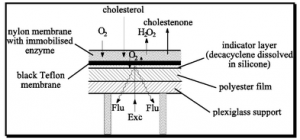
Fiber Optic Lactate Biosensor
The oxygen depends on the amount of fluorescence generated by the dyed film this is because oxygen has a reducing effect on the fluorescence. In the reaction mixture, the concentration of lactate is increased, oxygen is utilized and as a result, there is a proportional decrease in the quenching effect. Hence there is an increase in the fluorescence output can be measured
Optical Biosensors for Blood Glucose
For diabetes patients, blood glucose is more important to monitor. In this simple technique is used, i.e. Paper strips saturated with the reagents it contains glucose oxide, Horseradish Peroxidase, and a Chromogen. The following reactions take place. Using the portable reflectance meter it can measure the intensity of the color of the dye. In the world, wide the glucose strip industry is very high. The calorimetric test strips of cellulose covered with the suitable enzymes and reagents are in use for the view of more blood and the urine parameters.
The other optical fiber Biosensors are used in the devices of optical Biosensing it measures the p CO2 and in critical care and in surgical monitoring.
Piezoelectric Biosensors
The principle of piezoelectric Biosensor is used in sound vibrations, hence it is called acoustic Biosensors. The basics of the Biosensors are formed by the piezoelectric crystals and the characteristic frequencies are trembling with the crystals of positive and negative charge. By using the electronic devices we can measure the certain molecules on the crystal surface and alters the response frequencies using these crystals we can attaché the inhibitors. The Biosensors for cocaine in the gas phase have been developed by attaching the antibodies cocaine to the surface of the crystal.
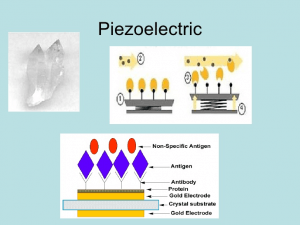
Piezoelectric Biosensors
Immuno–Biosensors
The immune Biosensors work on the principle of immunological specificity and mostly coupled with measurement on the Potentiometric Biosensors. There are a different configuration of probabilities for immune Biosensors some of them are given below and the figure shows the description

Immuno–Biosensors
- The immobilized antibody can directly combine through the antigen
- The immobilized antigen can combine with the antibody which can twist to a second free antigen.
- The immobilized antibody combined with the free antigens and enzyme-labeled antigen in opposition.
Applications of Biosensors
The applications of different types of biosensors are
- Food analysis
- Study of Biomolecules and their interactions
- Drug development, crime detection
- Medical diagnosis
- Environmental field monitoring
- Industrial process control
- Manufacturing of pharmaceuticals and replacement of organs
This article is about the types of Biosensors, how does it work, and Applications. I hope the given information in the article is helpful to give some good information and understanding the project. Furthermore, if you have any queries regarding this article and on electrical and electronic projects you can comment in the below section. Here is the question for you, what are the typical uses of Biosensor?
Photo Credits:
- Biosensor researchgate
- Electrochemical biosensor mdpi
- Blood Glucose Biosensor rbu
- Potentiometric Biosensor biologydiscussion
- Fiber Optic Lactate Biosensor rsc
- Immuno–Biosensors unsw